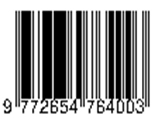POTENSI BAHAN CETAK EKSTRAK NATRIUM ALGINAT RUMPUT LAUT MERAH (Kappaphycus alvarezii) DALAM MENGHAMBAT PERTUMBUHAN Streptococcus mutans
Abstract
Keywords
Full Text:
PDF (Bahasa Indonesia)References
Amalina R, Sutanto D, Sunendar B. Perbandingan Tensile Strength, Tear Strength, Dan Reproduction Of Detail Bahan Cetak Alginat Sintesis Dengan Variasi Jumlah Nanoselulosa Dan Metakaolin Terhadap Jeltrate®. SONDE (Sound of Dentistry). 2018;3(1):1-5.
Budiono B, Susilaningsih E, Fatmasari D. Pengembangan instrumen penilaian kinerja keterampilan mencetak rahang bergigi teknik mukostatik. Journal of Research and Educational Research Evaluation. 2016;5(1):49-56
Febriani M. Alginate impression vs alginate impression plus cassava starch: analisis gambaran mikroskopik. STOMATOGNATIC- Jurnal Kedokteran Gigi. 2015 Dec 16;8(2):67- 73.
Pithon MM, dos Santos RL, Martins FO, Romanos MT. Cytotoxicity of dental alginates. Revista Odonto Ciência. 2010 Jun 13;24(3):270-3.
Hati AK, Multazamudin M, Iqbal M. Uji Aktivitas Antibakteri dan Kandungan Senyawa Aktif Ekstrak n-Heksan, Etil Asetat dan Etanol 70% biji Melinjo (Gnetum gnemon. L) terhadap bakteri Salmonella thypi dan Streptococcus mutans. Indonesian Journal of Pharmacy and Natural Product. 2018 Jul 31;1(1).
Nomura Y, Fujita Y, Ishihara Y, Kakuta E, Okada A, Maki K, Hanada N. Effects of cariogenic bacteria and sealant evaluated by International Caries Detection Assessment System. The Open Dentistry Journal. 2019 Dec 31;13(1) 512-519.
Ongo TA, Rachmadi P, Arya IW. Stabilitas dimensi hasil cetakan bahan cetak elastomer setelah disemprot menggunakan sodium hipoklorit. Dentino J Ked Gigi. 2014;2(1):83- 88.
Zulkarnain M, Singh JK. Pengaruh penambahan pati ubi kayu pada bahan cetak alginat terhadap stabilitas dimenisi model gigi tiruan. Jurnal Material Kedokteran Gigi. 2018 Jul 23;3(2):54-61.
Afriani W. Uji Perbandingan Aktivitas Antibakteri Serbuk Alginat Rumput Laut Cokelat (Sargassum SP.) dengan Variasi Agen Pengekstrak [Doctoral dissertation]. Banda Aceh: UIN Ar-Raniry.; 2019.
Salim Z, dan Ernawati. Info Komoditi Rumput Laut. Jakarta: Badan Pengkajian dan Pengembangan Kebijakan Perdagangan Al Mawardi Prima; 2015.
Sanger G, Kaseger BE, Rarung LK, Damongilala L. Potensi beberapa jenis rumput laut sebagai bahan pangan fungsional, sumber pigmen dan antioksidan alami. Jurnal pengolahan hasil perikanan Indonesia. 2018 Aug 16;21(2):208-17.
Suparmi S, Sahri A. Mengenal potensi rumput laut: kajian pemanfaatan sumber daya rumput laut dari aspek industri dan kesehatan. Majalah Ilmiah Sultan Agung. 2009;44(118):95-116.
Borkowski D, Krucińska I, dan Draczyński Z. Preparation of Nanocomposite Alginate Fibers Modified with Titanium Dioxide and Zinc Oxide. Polymers. 2020;12(5): 1-14.
Torres P, Santos JP, Chow F, dan dos Santos DYC. A Comprehensive Review of Traditional Uses, Bioactivity Potential, and Chemical Diversity of The Genus Gracilaria (Gracilariales, Rhodophyta). Algal Research. 2019;37: 288-306.
Trica B, Delattre C, Gros F, Ursu AV, Dobre T, Djelveh G, Michaud P, Oancea F. Extraction and characterization of alginate from an edible brown seaweed (Cystoseira barbata) harvested
in the Romanian Black Sea. Marine drugs. 2019 Jul 8;17(7):405.
Pasanda OS, Azis A. The Extraction of Brown Algae (Sargassum sp) Through Calcium Path to Produce Sodium Alginate. Jurnal Bahan Alam Terbarukan. 2018 Feb 21;7(1):64-9.
Rasyida A, Pradipta TR, Wicaksono ST, Pratiwi VM, dan Rakhmawati YW. Preliminary Study of Alginates Extracted from Brown Algae (Sargassum sp.) Available in Madura Island as Composite Based Hydrogel Materials. Materials Science Forum. 2019;964: 240-245.
Kadi A. Rumput laut sebagai produk alam dari Perairan Indonesia. Jurnal Oseana. 2014;39(3):31-40.
Sari ZA, Febriawan R. Perbedaan Hasil Uji Aktivitas Antibakteri Metode Well Diffusion dan Kirby baurer Terhadap Pertumbuhan Bakteri. Jurnal Medika Hutama. 2021 Jul;2(04): 1156-1162.
Handayani F, Warnida H, Nur SJ. Formulasi dan uji aktivitas antibakteri Streptococcus mutans dari sediaan mouthwash ekstrak daun salam (Syzygium polyanthum (Wight) Walp.). Media Sains. 2016 Apr;9(1):74-84.
Król Ż, Marycz K, Kulig D, Marędziak M, Jarmoluk A. Cytotoxicity, bactericidal, and antioxidant activity of sodium alginate hydrosols treated with direct electric current. International Journal of Molecular Sciences. 2017 Mar 22;18(3):678.
Aprilisna M, Ramadhany CA, Sunendar B, Widodo HB. Karakteristik dan Aktivitas Antibakteri Scaffold Membran Cangkang Telur yang Diaktivasi Karbonat Apatit. Majalah Kedokteran Gigi Indonesia. 2015;1(1):59-67.
Kubyshkin A, Chegodar D, Katsev A, Petrosyan A, Krivorutchenko Y, Postnikova O. Antimicrobial effects of silver nanoparticles stabilized in solution by sodium alginate. Biochemistry & molecular biology journal. 2016;2(2): 1-7.
Sofos JN. Antimicrobial effects of sodium and other ions in foods: a review 1. Journal of Food Safety. 1984 Mar;6(1):45-78.
Sarjit A, Dykes GA. Antimicrobial activity of trisodium phosphate and sodium hypochlorite against Salmonella biofilms on abiotic surfaces with and without soiling with chicken juice. Food Control. 2017 Mar 1;73:1016-1022.
Ducheyne P. Comprehensive Biomaterials II. 2nd ed. Philadelphia: Elsevier; 2017.p. 289- 313.
DOI: https://doi.org/10.33854/jbd.v10i1.1120
DOI (PDF (Bahasa Indonesia)): https://doi.org/10.33854/jbd.v10i1.1120.g483
Refbacks
- There are currently no refbacks.
Copyright (c) 2023 Inneke Dwi Lestari

This work is licensed under a Creative Commons Attribution-NonCommercial-ShareAlike 4.0 International License.




